I typically use Canva for infographic design and presentations, so for my virtual symposium presentation I decided to try Prezi.
Enjoy!
The Hyperlinked Library & Whole-hearted Librarianship
I typically use Canva for infographic design and presentations, so for my virtual symposium presentation I decided to try Prezi.
Enjoy!
The Hyperlinked Library & Whole-hearted Librarianship
A Power of Stories Program
I have always been interested in the stories of others, but I perhaps didn’t realize how vital stories are for my own sense of connection and empathy until I left the high-demand religion I was raised in. I was hungry for the stories of others like me, and hearing those stories helped me work through some complex feelings in a very difficult time of transition.
Then my mom got sick. After her passing I found a DVD in her office. I turned it on and there I saw my mom’s face. At some point in the years just before her illness, she had visited her local family history library and recorded herself telling some of her life stories. My sisters and I have also tried to ask our dad questions about his life and record them, as his memory and health decline due to advanced Parkinson’s Disease. These are artifacts I treasure.

My mom utilizing a digital storytelling program at her local family history library
As I have learned more about the power of stories in this class, I have thought about my parents and the stories they leave behind. I have thought about how so many stories have touched me and, at times, saved me. And I have thought about how many people have stories inside them, some that may never be heard, and how tragic that is.
These thoughts are what influenced my Inspiration Report. What barriers are there that prevent stories from being told? The greatest barrier I could think of was access: community members who have the most stories to tell are often the ones who cannot access services and programs that can help them tell their stories, whether because they are homebound or because they lack the tools. So, what can libraries do to encourage and support community members, of all ages and abilities, to share their stories?
As leaders in their communities and leaders in today’s digital world, libraries have a unique opportunity to help community members share their stories. Many libraries have existing place-based programs and technology for digital storytelling. However, very few have these same resources available for use remotely. Making storytelling resources available both in and out of physical library spaces will increase access for all patrons.
I propose Narratives Near & Far, a DIY digital storytelling program that aims to simplify the process and allow users to tell their stories wherever they are:
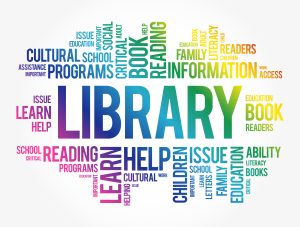
Image source: dizain, Adobe Stock
I have spent decades in early childhood education, and my library experience has been in a middle school library, so I was excited to learn more about Infinite Learning models. I had a hard time deciding which model I wanted to more deeply explore! I am hoping to pursue children’s or youth services in a public library when I graduate, and I think making learning fun in a library setting will be a big part of my job, so, while I think there is a lot of crossover between all three models, I am going to be writing mostly about the Library as Classroom model in this post.
As an early childhood educator, I know well that children (and, arguably, most adults) learn best through play. It may go against everything we have been conditioned to think of as “education,” (the misguided idea that learning only happens with formal instruction), but the best way to support learning is to provide enriching experiences and materials, and watch the magic happen! Because the library is, by its very nature, full of enriching materials, it is naturally very easy to support learning, with a little intentionality and awareness. @michael states in The Heart of Librarianship that “[t]he library as creative classroom means we approach the learning opportunities we create with thought, user-directed planning, and insights from research” (Stephens, 2016, p.128).
This reminds me of my time working in a middle school library just prior to the pandemic. We noticed that many students would use a library pass to leave class and come to the library to play Minecraft throughout the day. We decided that rather than blocking the game on library computers, as our predecessors had, we would find a way to make the game more purposeful/focused and learning-centered. Each month brought a new Minecraft challenge to the library, and we even instituted “Minecraft Mornings” so students could spend uninterrupted time playing together before school started each morning. What had created a sticky discipline issue previously instead became a student-centered, teamwork-oriented, learning-driven activity that made students excited to come to the library! Our library became a classroom as we embedded learning experiences into the activities that were already taking place there, and our students became active learners as they participated in activities they were interested in. In the Creative Classroom, students learn with others in a collaborative environment, by creating, exploring, and playing (Stephens, March 2016).
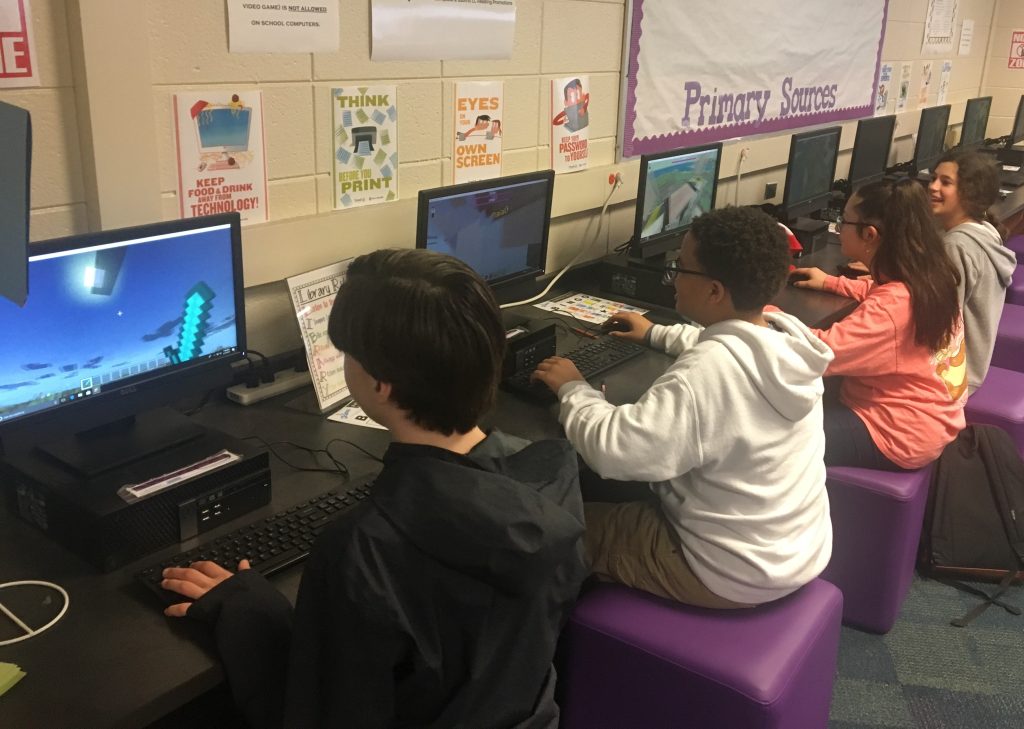
Students learning together through Minecraft!
There is a new library here in Northern Colorado – Greeley’s LINC (Library Innovation Center) – with the tagline “where creativity and possibility comes to life” (High Plains Library District, n.d., last para.). LINC was created in response to Greeley community members’ requests for “a place where children can be entertained while learning, where new technologies are made available to all, where teens and adults can learn new skillsets and a place where the community could gather for events” (Thomas, 2023, para. 3). LINC has really embraced the idea of Library as Classroom. Dr. Matthew Hortt, High Plains Library District executive director, calls LINC an “activity hub that links together a public library, an innovation center, and an arts space for adults and children that will spark interest, create curiosity, and inspire exploration” (My Greeley, 2023, para. 1). I haven’t yet had a chance to visit (it’s about an hour away from me), but it seems amazing, and my friends who live closer to it say it is a huge community asset!
LINC is housed in a 62,000 square foot structure full of innovative services and spaces for learning and community. There is a fully-equipped makerspace with 3D printers, laser engravers, die-cut machines, and a UV Printer. There is also a workshop where patrons can use woodworking equipment such as a CNC Router, a table saw, a planer, a lathe, and other industrial tools. There are classrooms, an art studio, a television studio, and a recording studio. For a cozy reading or remote working experience, LINC has an atrium with an indoor/outdoor fireplace, and a quiet reading room. There are also five study rooms, four meeting rooms, two collaboration spaces, two computer classrooms, two general classrooms, and a large event space. For younger patrons, LINC is home to a hands-on learning children’s exhibit and a two-story, large-scale interactive art installation (my friends with young kids love this area!), as well as a Children’s Library with a hobbit door entrance, storytime room, LED-light patterned sky, and fun architectural features for kids to explore. For older kids and teens, there is a gaming room next to the Children’s Library (High Plains Library District, n.d.).
In addition to the space, LINC offers a variety of engaging programs, such as: the Youth Biz Academy for Young Entrepreneurs, Crafty Teens arts & crafts club for tweens and teens, community groups such as fiber arts classes and woodcarvers clubs, the Social Club for high schoolers, Playdate Cafe for children and caregivers, Coding Club, Music Production workshops, STEAM Storytimes, and much more (High Plains Library District, 2024)!
For a city of around 112,000 (United States Census Bureau, 2023), LINC is a really impressive community achievement. There are plenty of spaces and opportunities for community members to come together in collaboration and learn through creating, exploring, and playing. It is a prime example of connected learning, and can be a model for other librarians. Though not all libraries will have the space, facilities, materials, or funding of LINC, the concepts and framework at the heart of LINC can be emulated. Nygren (2014) says, “In the ‘connected learning’ approach, learning is accelerated when it is powered by an individual’s interests and passions, supported by peers, and in spaces where an individual feels valued and safe.” An environment and programs that support this “connected learning” are what we should be striving to create in our libraries.
EDITED TO ADD (12/5/24):
I was in Greeley the other day taking my son on a college campus visit (!!!!), and we decided to check out LINC library while we were there. It was even cooler than I could have imagined! It is a bright, welcoming, calming space. The children’s area and art installation are breathtaking! The resources they have available are seriously impressive (the woodshop alone! Wow!). My 18 year old kept saying that it was the coolest library he’d ever seen, and we both wished we had had access to something like it when he was younger (a free *indoor* space to let my kids explore and play + books = all I needed as a young mother!!!!). I wish we lived closer so we could take advantage of all the programs and resources they have to offer, but we did both get a library card so at least we can acccess their collection on Libby for now!
References
dizain. (n.d.). Library word cloud collage, education concept background [Graphic]. Adobe Stock. https://as2.ftcdn.net/v2/jpg/03/22/58/13/1000_F_322581328_kXiiht8JzlvcBeChodrX25FnoMZUWp26.jpg
CBS Colorado. (2023, May 24). LINC, Greeley’s new $30 million investment, revolutionizes libraries as we know them [Video]. YouTube. https://youtu.be/y07nCbzahaE?si=Rw7s2l0BRX7kL1NV
High Plains Library District. (n.d.). LINC library innovation center. Retrieved on November 29, 2024, from https://www.mylibrary.us/linc/
High Plains Library District. (2024, November-December). HPLD calendar – Upcoming events. https://highplains.libcal.com/calendar/hpld?cid=8181&t=d&d=0000-00-00&cal=8181&cm=4559&inc=0
My Greeley. (2023, May 5). Greeley’s new LINC library, a ‘connector for the community.’ City of Greeley. https://mygreeley.com/linc-library-innovation-center/
Nygren, A. (2014). The public library as a community hub for connected learning. IFLA. https://library.ifla.org/id/eprint/1014/1/167-nygren-en.pdf
Stephens, M. (2016). The heart of librarianship: Attentive, positive, and purposeful change. ALA Editions.
Stephens, M. (2016, March 29). Learning everywhere: The hyperlinked library as classroom. SJSU School of Information. https://ischool.sjsu.edu/ciri-blog/learning-everywhere-hyperlinked-library-classroom
Thomas, D. (2023, May 24). LINC, Greeley’s new $30 million investment, revolutionizes libraries as we know them. CBS News Colorado. https://www.cbsnews.com/colorado/news/linc-greeley-investment-revolutionizes-libraries-northern-colorado/
United States Census Bureau. (2023, July 1). Quick facts Greeley city, Colorado. https://www.census.gov/quickfacts/fact/table/greeleycitycolorado/PST045223
I really enjoyed exploring the “Power of Stories” module. I have always been enthralled with human stories, and the empathy and connection I feel when I hear others’ stories. One piece that particularly stood out to me – that was actually from the “New Models” module but fits well here – was Anythink’s “Get To Know Your Neighbor” program (video below). I love the idea of providing a comfortable setting for strangers to get to know each other.
Stories help us see each other more wholly. We learn about other’s cultures, histories, families, fears, hopes, and dreams. There is real transformative power when we can see each other’s humanity through stories, and I think the potential for positive change is so high when we can get to know each other – and our differences – on a personal, individual level.
After learning about Anythink and this event, I was curious about what other storytelling programs might be local to me. I found a few that piqued my interest:
Young Chautauqua
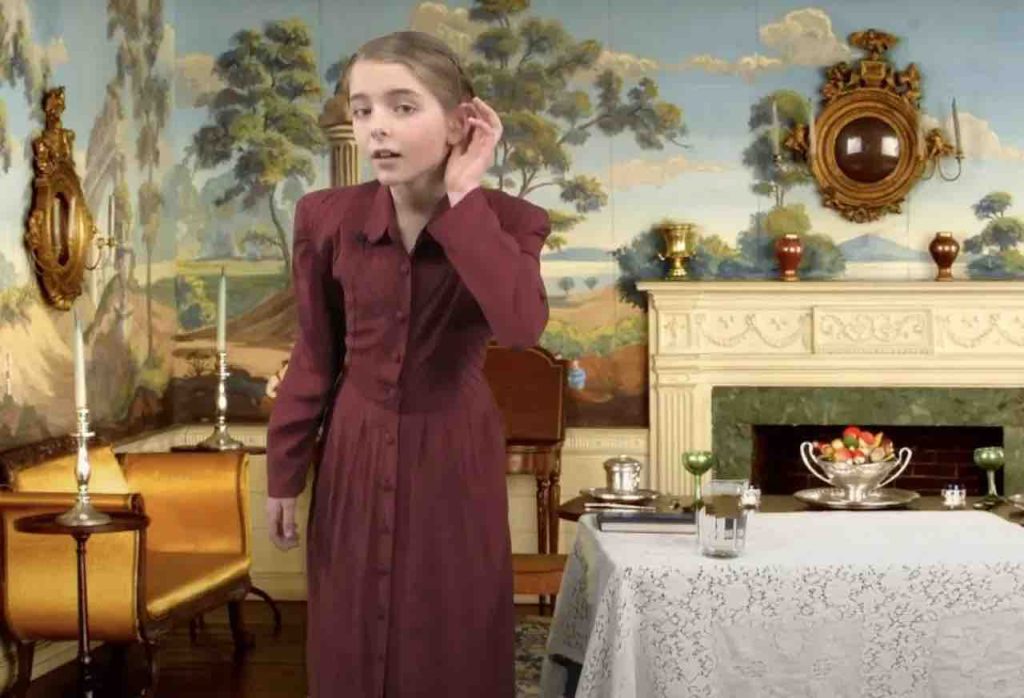
Image source: Estes Valley Library, Estes Park Trail Gazette
The Estes Valley Library in Estes Park, Colorado, hosts Young Chautauqua, a historical storytelling program for children in grades 4 through 12. In this nationally-recognized annual history program, participants choose a historical figure to research. They study their historical figure, find a costume to represent them, and memorize some of their speeches or writings to perform. The program meets weekly for three months and culminates in community performances of monologues and Q&As (Young Chautauqua Estes Park, n.d.).
https://calendar.estesvalleylibrary.org/event/13200374
https://sites.google.com/psdr3.k12.co.us/young-chautauqua-estes-park/home
Black History Live!
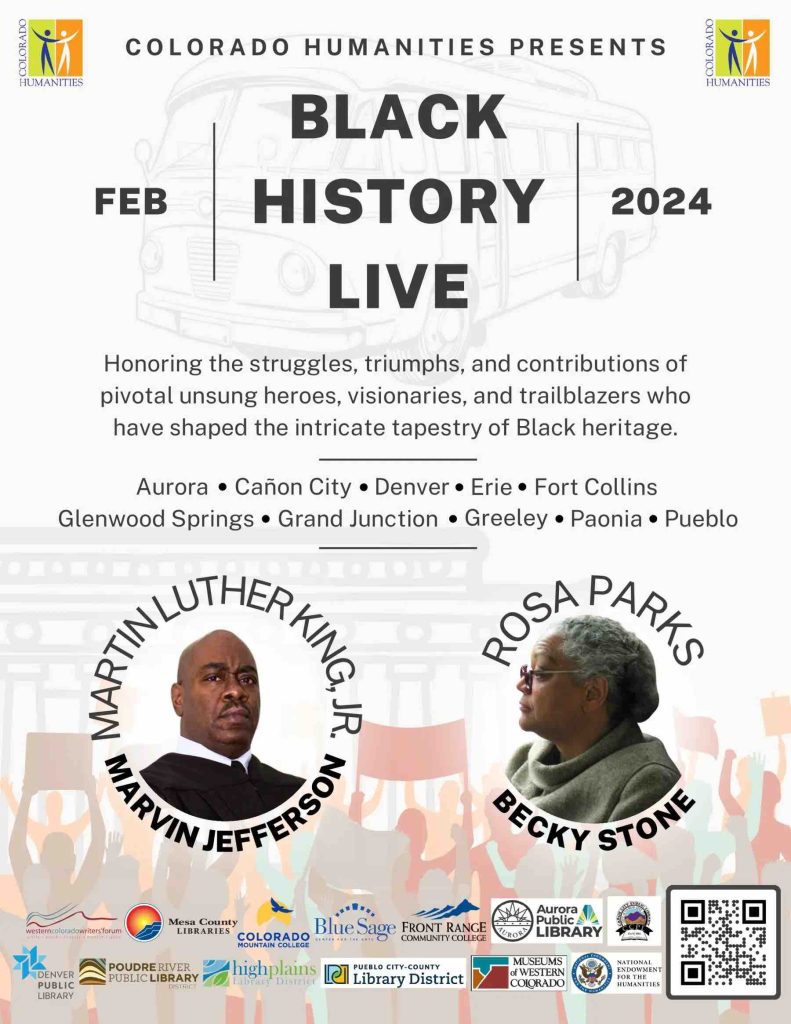
Image source: Denver Public Library
Colorado Humanities’, a 501(c)(3) nonprofit organization dedicated to humanities education in Colorado, hosts it’s Black History Live! programs throughout the year in public libraries across the state. Black History Live! recognizes the important contributions of African Americans through 1st-person dramatizations of historical figures. Performances consist of a 40 minute monologue, followed by 20 minutes of Q&A with the actor both in character and out. Different prominant historical figures are represented each year: Martin Luther King, Jr. and Rosa Parks were depicted in 2024, with 2025 to feature living-history portrayals of Harriet Tubman and Louis Armstrong (Colorado Humanities, n.d.).
https://www.denverlibrary.org/library-calendar/image-dialog/56063?alternative_text=Black%20History%20Live
https://coloradohumanities.org/programs/black-history-live/
La Llorona Festival
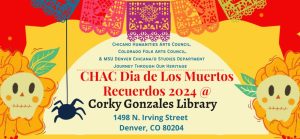
Image source: KUVO
The Corky Gonzalez Library, in Denver, Colorado, recently held it’s 5th annual storytelling event that tells the story of and pays tribute to the legendary Weeping Woman, or La Llorona. Historians and storytellers helped bring to life the mysterious woman and the myths surrounding her story. La Llorona Festival was held not only to honor the legend of La Llorona, but also to honor the cuentistas (or storytellers) of Latine cultures, who “honor an art form that adds a rich cultural presence to who we are as a people” (Garcia, as quoted by KUVO, n.d.).
Spellbinders Oral Storytellers of Larimer County

Image source: Spellbinders Oral Storytellers of Larimer County, Facebook
Spellbinders Oral Storytellers of Larimer County was established in Fort Collins in 2004 and is the 10th Colorado chapter of national organization Spellbinder, a 501(c)(3) nonprofit founded in 1988. Over 45 Spellbinders volunteers share the power of stories through personal tales of humor, struggle, and triumph in elementary schools, senior homes, and community events in Northern Colorado (Spellbinders, n.d.).
Exploring this organization has given me some great ideas about how public libraries could collaborate with an organization such as this to not only bring stories to the public but also to give interested storytellers a venue and a voice. The Spellbinder website also contains some great resources that libraries could use when thinking about how to involve storytelling in their programs and events (this article, Tips On Sharing Family Stories, is a good place to start).
These are just a few of the available storytelling-related resources and programs in my area, but learning about them has sparked a newfound curiosity in me. I think libraries are the exact right place to encourage communities to share and hear stories, and I am excited to explore more about how to use storytelling in libraries and watch as the power of stories helps strengthen my community.
References
Anythink Libraries. (2016, December 21). Get to know your neighbor. [Video]. YouTube. https://youtu.be/rzLI-aqFzDQ?si=aq_Q7TgjcVvw9hmU
Colorado Humanities. (n.d.). Black history live. Retrieved on November 25, 2024, from https://coloradohumanities.org/programs/black-history-live/
Denver Public Library. (n.d.). Featured image. [Infographic]. Retrieved on November 25, 2024, from https://www.denverlibrary.org/library-calendar/image-dialog/56063?alternative_text=Black%20History%20Live
Estes Valley Library. (2024, February 7). Building on their own findings, costumed performers will present a first-person monologue as their historical figures. [Photograph]. Estes Park Trail Gazette. https://www.eptrail.com/2024/02/07/interact-with-historical-figures-at-young-chautauqua-performances/
KUVO. (n.d.). Dia de Los Muertos — La Llorona Festival. Retrieved on November 25, 2024, from https://www.kuvo.org/event/dia-de-los-muertos-la-llorona-festival/
Spellbinders. (n.d.). Larimer County storytellers. Retrieved on November 25, 2024, from https://spellbinders.org/our-affiliates/affiliate-larimer-county/
Spellbinders Oral Storytellers of Larimer County. (2019, August 28). Storytelling season is here…! [Photograph]. Facebook. https://www.facebook.com/SpellbindersOralStorytellersofLarimerCounty/photos/pb.100070382177259.-2207520000/2496949840563833/?type=3
Young Chautauquans Estes Park. (n.d.). Welcome, Young Chautauquans 2024-2025! YAY Young Chautauqua! Retrieved on November 25, 2024, from https://sites.google.com/psdr3.k12.co.us/young-chautauqua-estes-park/home
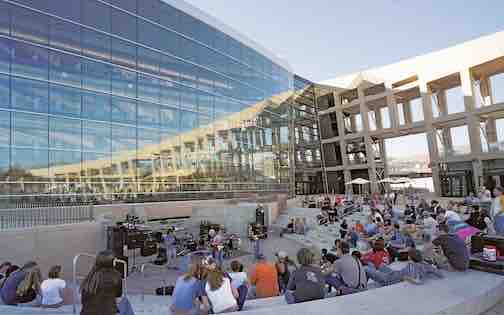
The open-air amphitheater of the Salt Lake City Library is a central hub for gathering and hosts free performances and programs.
Image source: Safdie Architects
I have been putting off writing this blog post because, I’ll be honest, reflecting on the future of libraries and library work has had me in a bit of a tailspin lately. The fatalistic part of me thinks that the future, in general, feels so unstable, and libraries, more specifically, feel doomed. As Eric Klinenberg says in his book Palaces for the People: How Social Infrastructure Can Help Fight Inequality, Polarization, and the Decline of Civic Life (as quoted in an interview with Gaetani, 2018):
‘social order now feels precarious’ and our ‘collective project is in shambles.’ Ultimately, ‘the systems we build in coming years will tell future generations who we are and how we see the world today. If we fail to bridge our gaping social divisions, they may even determine whether that ‘we’ continues to exist.’ (quest. 4)
As I think about how libraries impact our society – and what might happen if we were to lose them – my thoughts turn to the idea of community and “third places.” A “third place” is a social environment that is separate from the predominant two social settings in humans’ lives: the home (first place) and the workplace (second place). The term was coined by sociologist Ray Oldenberg in his 1989 book The Great Good Place: Cafés, Coffee Shops, Bookstores, Bars, Hair Salons and Other Hangouts at the Heart of a Community (second edition published in 1997), in which he describes “happy gathering places…’homes away from home’ where unrelated people relate” (p. ix).
What Makes a Third Place?
Oldenburg defines third places by eight generally-shared characteristics:
Third places unify communities without barriers, allow for networking and the sharing of resources, foster intergenerational relationships, provide free unstructured exploration, and promote social interchange and the exchange of ideas. Unfortunately, urban planning and capitalist interests have led to a decrease in an already-low presence of third places in the U.S (as compared to other countries around the world). Oldenburg argues that the decline of third places has contributed to the deterioration of community and civility and led to increased isolation and division within American society.
This is where the public library steps in to play a vital role.
In our digital age, with the internet and e-books, audiobooks, online libraries, online databases, streaming services, and online shopping, the public library is no longer only (or the primary) place to access books and information. Now and on the horizon, public libraries need to meet not only the information and digital needs of patrons, but also serve as community hubs and social services, or “third places.” As the Covid-19 pandemic shutdown showed us, while technology will continue to make our lives more convenient and help connect us to each other, digital connectedness cannot make up for a lack of physical human connection, social interaction, and cultural exchange.
How Can Libraries Function as Third Places?
In his 2001 book Bowling Alone: The Collapse and Revival of American Community, Robert D. Putnam discusses two types of social capital: bonding, in which people with a similar sense of identity are brought together, and bridging, in which disparate groups of people are brought together in a common cause. Libraries can provide both bonding and bridging, by giving community members a place to meet with others like them (bonding) as well as by providing a space and programs and services to allow community members to come together in spite of (or because of) differences (bridging).
Libraries are one of the only truly free, accessible community spaces that remain in existence in the U.S. While libraries at their foundation fulfill the eight characteristics outlined above, Colorado’s Anythink Library is a stellar example of how libraries can foster these ideals to more richly function as third places. Anythink‘s whole philosophy is based on the idea that community members can do anything they can think of there, instructing patrons to “find delightful opportunities to learn about anything under the sun in the most beautiful, comfortable spaces. Our libraries are community assets that belong to you…The more imaginative and collaborative we can be, the better we can serve our customers” (Anythink Libraries, n.d., brochure).
I spent some time in Spain several years ago (*see images below), and I fell in love with the abundance of third places and how easy it was to find community there. Our infrastructure in the U.S. is so vastly different that it is difficult to create third places that so conveniently and easily meet the needs of our sprawled-out society. However, Anythink is doing just that. With seven branches plus outreach services, Anythink is bringing third places to the members of the Adams County community. An example of this is their Community Center Branch in Thornton, Colorado. Partnering with the city of Thornton, the library is housed within the Community Center and includes a reading fireplace, study rooms, teen space, children’s space, and a studio makerspace, in addition to recreational spaces such as a gym, dance studios, and boxing gyms, as well as shared spaces perfect for community events and gatherings (community center amenities are available for a very nominal fee, ranging from $2.00 – $5.75 daily for Thornton residents) (City of Thornton, n.d.).
I am also quite inspired by Anythink’s Nature Library that is under construction in Thornton. In a society such as ours, where being outdoors often means being alone (either on an isolated nature trail or in one’s own private backyard), the potential for a common outdoor space to become a third place for Thornton community members is promising.
While I have mostly focused on physical third places here, I don’t want to overlook the potential for online third places to also meet the needs of communities in today’s digital age. During the Covid-19 crisis, libraries helped fill the role of third-place when they moved services online to offer virtual homework help, storytimes, yoga classes, concerts, Zoom social hours, and more. In this way, the Internet has become a kind of a third place as digital communities have emerged to meet the needs of a growing digital society. There are so many possibilities for libraries to fulfill the needs of communities as third places, both physically and digitally. Wood states, “Whether onsite or online, libraries have proven their third-place designation” (Wood, n.d., para. 2).
My Reflection on the Future of Libraries as Third Places
Learning about the importance of third places, and how libraries can act as third places, will inform how I look at my work as a librarian moving forward. While I love books and reading, and that was definitely a driving force in my decision to pursue librarianship, my love for community and serving and connecting with my fellow humans is at the forefront of my passion for this work. I am committed to better meeting the needs of my community through library spaces, programs, and services to foster improved social connection, mental health, digital literacy, and accessibility. Historically, third places have often been the backbone of human rights movements (Oldenburg, 1997), and while the future remains uncertain, I have hope that libraries and librarians will continue to serve communities as third places through their constant committment to providing free access to information and services.
*Third Places in Europe

Clockwise from top left: a public “platz” in Salzburg, Austria allows for social gathering and impromptu encounters; an intergenerational game of “parchís” in a “plaza” in Alicante, Spain; a “piazza” in the pedestrian zone of Bologna, Italy welcomes families and friends to gather while walking and cycling and visit in groups on building steps, city walls, and chairs; children meet to play at a “plaza” in Alicante, Spain; a public art installation in a “plaza” in Madrid, Spain invites conversation and connection.
References
Anythink Libraries. (n.d.). Anythink brochure. Retrieved on November 20, 2024, from https://www.anythinklibraries.org/sites/default/files/imce_uploads/Anythink%20Brochure.pdf
Anythink Libraries. (2012, October 31). A day in the life of an Anythink Library [Video]. YouTube. https://youtu.be/VLUFz5aGFQc?si=QRXqRrLeiIOKFeGU
City of Thornton. (n.d.). Thornton community center. City of Thornton: Parks & Recreation. Retrieved on November 20, 2024, from https://www.thorntonco.gov/parks-recreation/recreation-facilities/thornton-community-center
Gaetani, M. (2018, November 11). Q&A with Eric Klinenberg. Stanford University: Center for Advanced Study in the Behavioral Sciences. https://casbs.stanford.edu/news/qa-eric-klinenberg
Oldenburg, R. (1997). The great good place: Cafés, coffee shops, bookstores, bars, hair salons and other hangouts at the heart of a community (2nd ed.). Da Capo Press.
Putnam, R. D. (2001). Bowling alone: The collapse and revival of American community. Simon & Schuster.
Safdie Architects. (n.d.). Salt Lake City Public Library. [Photograph]. Retrieved on November 20, 2024, from https://www.safdiearchitects.com/projects/salt-lake-city-public-library
Wood, E. (n.d.). The rise of third place and open access amidst the pandemic. American Library Association: Intersections. Retrieved on November 19, 2024, from https://www.ala.org/advocacy/diversity/odlos-blog/rise-third-place
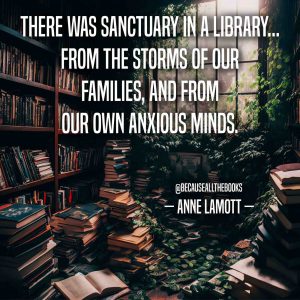
Anne Lamott Quote.
Image Source: Because All The Books
I had an unexpected reaction reading an article about library environments, and I have been pondering on it for a long time now. It took me to a vulnerable place that I wasn’t sure I wanted to explore more deeply. But, it is still on my mind so I am now putting pen to paper – digitally – and getting personal.
I have written briefly here about how my mom found her home in public libraries all through her life. To really understand what I mean when I say the library was my mom’s home, you have to understand my mom. It’s hard to depict my multi-faceted mother with mere words. She was robustly healthy, fiercely independent, a tall towering tree steady and rooted in my life. She was brilliant and loved learning and teaching. She was also mentally ill. My mother loved me deeply and gave me everything, yet my childhood was unstable. There were times we struggled to make ends meet, and there were periods of homelessness in her life, when, while we were with my dad, she slept in her car or in storage units or at rest areas and campgrounds.

Mom using the library payphones, 1990ish
Through it all, there was the public library. My mom thoroughly utilized all the public library had to offer. During the heat of the summer, we took advantage of the cool air conditioning, free entertainment (books, videos, magazines, and books on tape all in one place and all free!), cultural/park passes, summer reading programs, and access to payphones, copy machines, and, later, computers. We took our piles of borrowed books next door to the park to read while my mom napped in the shade of a willow tree. In the winter, we went to the library to escape the snow, shortened days, and our own cabin fever. We met up with friends and browsed the stacks while our moms did whatever moms do when they can stop worrying about their children for a few moments. We stocked our own bookshelves with books purchased for pennies at the annual library book sale. In a childhood filled with change, the public library was a constant in my life.

Where I spent countless hours:
The Troy Public Library (Troy, Michigan)
My mom died 2 years ago of an autoimmune illness compounded by Covid. For many years prior to Covid, my mom lived alone (90 miles from her closest family), worked a part-time fast food job that helped meet her social needs as much as it helped supplement her social security payments, volunteered with several local organizations (including a family history center and a local bookstore), and spent the rest of her time at her small public library. Like many older adults, the coronavirus pandemic had a profound effect on her health and quality of life. She suddenly found herself completely isolated and cut off from her entire world. In my mom’s case, she did not have internet access except at the library. When Covid shut down the world, our family (scattered throughout California, Utah, and Georgia) tried to stay connected with weekly Zoom calls. When my mom’s library closed its doors, not only did she lose her local social community, she also lost access to her family. I remember her speaking about how disappointed she was when her library had to close its doors, and how relieved and thrilled she was when they reopened. At the time I tried to discourage her from visiting even after they reopened, concerned for her health and safety. I didn’t truly understand just how much she relied on the library until after she passed and I thought about how lonely her last few years of life had been.

Mom using the library computers, 2021
Reading this article helped me further understand just how vital public libraries can be to so many people: ‘Free, non-judgemental, accessible’: How your local library is a sanctuary of health and wellness
The article speaks of an “epidemic of loneliness” (Angela Savage, as quoted by Hasan, 2023, para. 11) and how libraries can help combat loneliness. Because many people who face mental health issues are left alone, it can be hard for them to trust, to feel they can share their stories without judgement. The library can be a sanctuary, as a place that is “free, non-judgemental, trusted, and accessible to everyone. There’s no stigma involved in coming into a library and we feel that we can offer safe and welcoming spaces for people who might otherwise experience discrimination” (Savage, as quoted by Hasan, 2023, para. 15).
Libraries can provide a range of services that support social connection and contribute to physical and mental health. Libraries can co-design programs and services with community members to create user-centered experiences, such as book clubs, craft groups, game nights, movie nights, conversation clubs, etc. In addition, libraries can also connect patrons to local mental health resources and information. In some cases, libraries provide necessities that many people, especially low-income, unhoused, disabled, and senior patrons, depend on for quality of life.
I love this 2018 video from Libraries Change Lives (an initiative of State Library Victoria and Public Libraries Victoria) that talks about some of the things the public library has to offer and how libraries can change lives:
Watching @michael ‘s lecture video Covid and Libraries (2022), it was so interesting for me to learn about how various libraries around the country handled the pandemic shutdowns. I learned of so many creative ways that libraries helped their communities remain connected, and I think about how beneficial some of those services would have been for my mom at that time if she had had access to them. Particularly, I love the idea of penpal services to homebound patrons, Anythink’s process of reaching out to seniors in their library database, and Alameda County Public Library’s Kind, Connected Conversations (slides 6-8).
While we hopefully will not face pandemic-level shutdowns again for a long time, reflecting on the pandemic has made me so much more aware of the life-changing potential and power of libraries, and how I can best meet the needs of library patrons in their day-to-day lives. I feel a tremendous responsibility to take a whole-hearted approach as I move forward in my career, to remember and consider all library patrons, and to serve all library patrons, in whatever capacity they need. I know that for some the library truly is their home, and library services can be life-saving.
References
Because All The Books. (n.d.). Sanctuary in the library. [Image with Words]. Pinterest. https://pin.it/437kWQUmV
Hasan, T. N. (2023, June 27). ‘Free, non-judgemental, accessible’: How your local library is a sanctuary of health and wellness. SBS Bangla. https://www.sbs.com.au/language/bangla/en/article/free-nonjudgmental-and-accessible-how-your-local-library-is-a-sanctuary-of-health-and-wellness/t15blzsi9
Public Libraries Victoria. (2018, November 7). Libraries change lives – Campaign launch [Video]. YouTube. https://youtu.be/jGfSZsE0kAI?si=sJhEkb4fBG37IFKe
Stephens, M. (2022). Hyperlinked library master lectures 2022: Covid and libraries. [Lecture Video]. Panopto. https://sjsu-ischool.hosted.panopto.com/Panopto/Pages/Viewer.aspx?id=40c6f8af-beab-4fe2-9068-aef3013e9ff1
Vijayakumar R. (2012, July 24). Troy Public Library. [Photograph]. Foursquare City Guide. https://foursquare.com/troypubl3915871?openPhotoId=500ecf88e4b03fb3d37c37ba
I live in Fort Collins, Colorado, and one of my very favorite things about living here is how bike-friendly the city is and just how easy it is to get around. Before moving here, I spent several years living in a suburb of Atlanta that had a lot of traffic and no sidewalks or bike lanes, and I never felt that I or my kids were safe walking or riding our bikes, so it was a relief and a joy to move somewhere that prioritizes safe infrastructure for pedestrians.
When thinking about what programs could benefit my community, my thoughts naturally went to bike services. I love that there are already so many city programs and amenitites for cycling and bike commuting, but I feel there is a gap in accessibility. While many kids and adults use bicycles to get to school and work and for recreation, there are a lot of barriers for families and individuals who cannot afford the initial investment or ongoing maintenance required to have a bike.
To overcome these barriers, my plan – Ride FoCo – implements bike services and programs, including bike lending, in public libraries in Fort Collins:
Action Brief (Full Slides) by Catherine Kemeny Gambrell














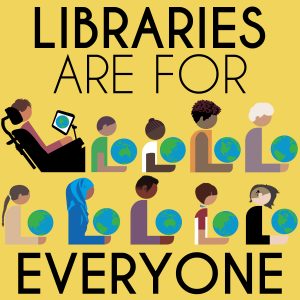
image source: Hafuboti
As I have learned more about the concept of a “hyperlinked library,” I have realized that it is woven into every aspect of librarianship and is the heart of what I find so important and special about librarianship: the ability – and responsibility – to create connections. When I think about creating connections, I think of how important it is for each person to feel welcomed and celebrated and to see themselves in their library. This can take on many forms, but in this blog post I will focus on library collections and how library materials, displays, and book-centered programs can foster an inclusive and welcoming library environment.
One concept that has stuck with me since early in my career as an educator is Dr. Rudine Sims Bishop’s idea of books being “mirrors, windows, and sliding glass doors.” In Sims Bishop’s (1990) article she states:
| “Books are sometimes windows, offering views of worlds that may be real or imagined, familiar or strange. These windows are also sliding glass doors, and readers have only to walk through in imagination to become part of whatever world has been created or recreated by the author. When lighting conditions are just right, however, a window can also be a mirror. Literature transforms human experience and reflects it back to us, and in that reflection we can see our own lives and experiences as part of the larger human experience. Reading, then, becomes a means of self-affirmation, and readers often seek their mirrors in books.” |
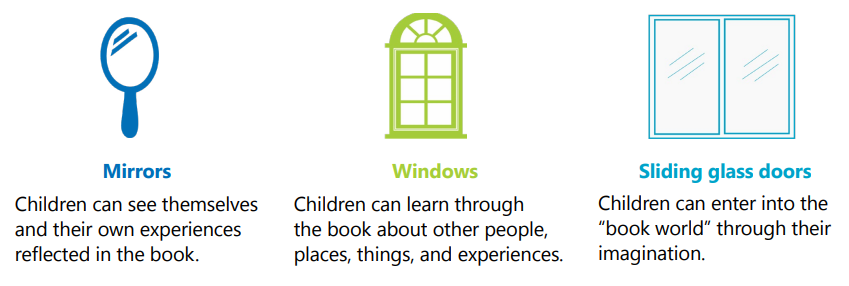
image source: Tandem
Books help us understand ourselves and our places in society, and they help us understand others. It is so important, then, that our book collections (and displays and programs) are wide, varied, and diverse. While specially-designated times – such as Black History Month, Jewish American Heritage Month, Asian American and Pacific Islander Heritage Month, Pride Month, Latine Heritage Month, and Native American Heritage Month – provide libraries with the opportunity to specifically highlight these communities, it is essential to create a safe and welcoming space all year long, through diverse and inclusive collections, displays, and programs.
To ensure that libraries serve as windows, mirrors, and sliding doors:
*learn about the identities, issues, and interests relevant to your community members, and collaborate with community organizations to provide personalized events and programs;
*include patrons in book selection;
*read diverse books aloud often, such as at storytimes and library events;
*include diverse people and cultures in all themes (for example: when highlighting water conservation/environmentalism, include books not only about local practices but also books about practices from various cultures and around the world);
*rethink what perspectives and positions are prioritized and privileged in books used in displays and programs (for example: when highlighting the fight for Civil Rights in America, include stories of the Black women who were not always at the forefront but were instrumental in the success of the Civil Rights Movement);
*examine which books and authors are most often spotlighted and promoted in your library, and ensure that displays include books written about diverse characters and by diverse authors, and include current stories and voices and not only books about cultures in faraway times and faraway places;
*ensure that books about diverse characters are about more than their identities; their cultures/identities are part of the story but are not the whole story (make sure we are not providing “foggy mirrors” or “too-small windows” (Enriquez, 2021));
*implement multimodal displays and programs – visual and performing arts, writing, digital composition, materials and programs designed for sensory-sensitive individuals and others for sensory-seeking individuals, etc. – to encourage engagement for all interests and ability levels
(Enriquez, 2021).
Here are some useful resources for creating inclusive libraries:
Overall
*Fostering Diversity: Public Libraries as Inclusive Spaces for Community Celebration
*Developing a Library That’s REALLY For Everyone
Collections
*Social Justice Books
*School Library Journal (Collection Diversity Audits)
Displays
*Increasing Circulation of Your Inclusive Library Collection
Programs
*Committing to Equity
*Accessible Library Programming Examples
*Programming Librarian
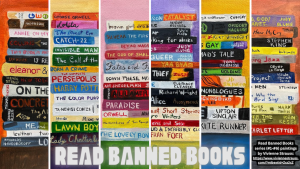
Read Banned Books, created by C. Kemeny Gambrell with artwork by Vivienne Strauss (used with permission): https://www.viviennestrauss.com
I can’t write about inclusive libraries without commenting on the disturbing increasing trend of book banning. In libraries across the United States, censorship and book banning has become a pervasive issue in recent years. In 2019, the American Library Association reported 377 book challenges; in 2022 that number was an alarming 1,269. According to PEN America (Meehan & Baêta, 2024), there have so far been more than 10,000 instances of book bans in the 2023-2024 school year. This number is nearly triple that of the previous school year (3,362). Organized groups are increasingly targeting library boards with disruptions and challenges at public comment sessions, primarily challenging diverse content such as books addressing racism and LGBTQIA+ issues (American Library Association, 2023).
Without access to these books, libraries cannot create inclusive spaces. However, even in areas where censorship is rampant, libraries can provide internet access, technology such as computers, laptops, iPads, and Wi-Fi, and the borrowing of e-books and audiobooks through programs and apps such as Overdrive, Libby, and Hoopla. Libraries in less hostile areas can also highlight diverse authors/works and books that have been banned/challenged. In April 2022, in response to increased efforts to remove books from library shelves, New York City’s Brooklyn Public Library (BPL) launched an initiative called “Books Unbanned,” giving teens and young adults aged 13-21 anywhere in the U.S. free access to BPL e-cards and the ability to borrow any e-book in BPL’s collection. Four other public libraries (Boston, L.A. County, San Diego, and Seattle) have since joined the program. Similarly, in July 2023, the Digital Public Library of America launched its “Banned Book Club,” which provides users with access to banned books in locations (in the U.S.) where titles have been banned (Parker, 2023). It is imperative that we act now to ensure that the right to read remains protected, through political advocacy for free expression, against censorship, and in support of libraries.
As saywhatnathan1 writes, “diversity means disruption” (2018). Creating truly welcoming and inclusive spaces requires intentionality and consistent reflection, examination, and evaluation, and it is all worth it to ensure that libraries truly are – and remain – a place for everyone!
References
American Library Association. (2023, March 22). American Library Association reports record number of demands to censor library books and materials in 2022 [Press release]. https://www.ala.org/news/press-releases/2023/03/record-book-bans-2022
Enriquez, G. (2021). Foggy mirrors, tiny windows, and heavy doors: Beyond diverse books toward meaningful literacy instruction. The Reading Teacher, 75(1), 103–106. https://doi.org/10.1002/trtr.2030
Hafuboti. (n.d.). Libraries are for everyone: English [image]. Retrieved on October 20, 2024, from https://www.hafuboti.com/2017/02/02/libraries-are-for-everyone/
Meehan, K., & Baêta, S. (2024, September 23). Memo on school book bans from PEN America. Pen America. https://pen.org/memo-on-school-book-bans-2023-2024-school-year/
Parker, C. (2023, July 25). Readers can now access books banned in their area for free with new app. Smithsonian Magazine. https://www.smithsonianmag.com/smart-news/banned-book-club-app-180982592/
saywhatnathan1. (2018, November 28). Diversity means distruption. Archival Decolonist. https://archivaldecolonist.org/2018/11/28/diversity-means-disruption/
Sims Bishop, R. (1990). Mirrors, windows, and sliding glass doors. Perspectives: Choosing and Using Books for the Classroom, 6(3). Retrieved from https://scenicregional.org/wp-content/uploads/2017/08/Mirrors-Windows-and-Sliding-Glass-Doors.pdf
Tandem. (n.d.). Mirrors windows doors graphic [image]. Retrieved on October 20, 2024, from https://www.tandembayarea.org/our-programs-2/book-collection/mirrors-windows-doors-graphic/
Hello! I am Catherine (she/her). I live in northern Colorado with my partner, our two amazing teenagers, our beloved terrier-hound mutt, and 7 hens.


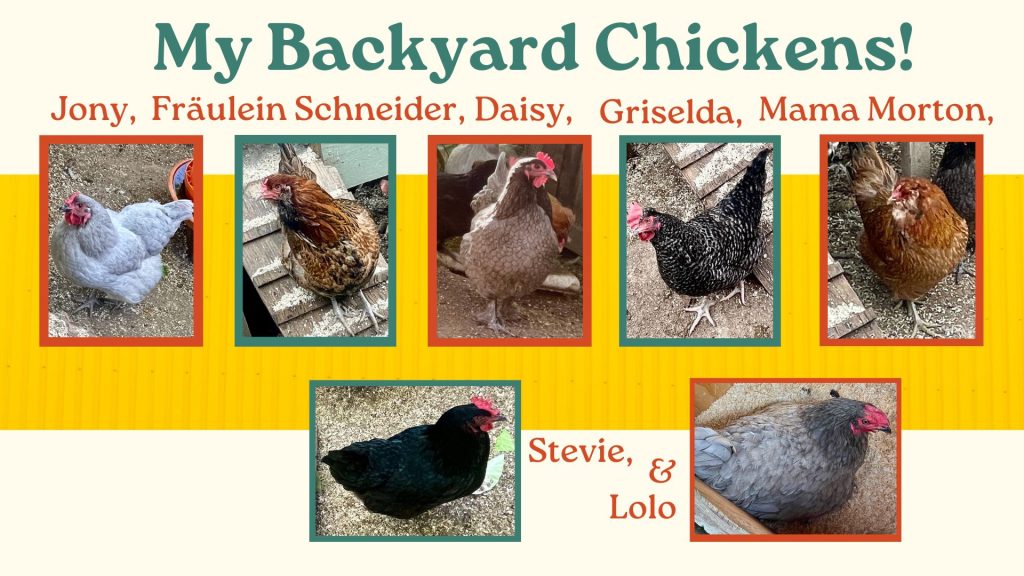
I graduated with my Bachelor’s Degree in Sociology over 20 years ago, & have been a stay-at-home mom for the past 17 years, while working at a Catholic preschool & a public middle school library for 8 of those years. I am currently almost halfway through the MLIS program at SJSU and hope to pursue public librarianship in children’s/youth services. I am taking Hyperlinked Library this semester because I have heard great things about the class and professor, and because I care deeply about library access for all and think this class will help me think about new ways to reach and engage all library users (and potential library users).
Outside of school and work, I love spending time with my family and friends, traveling, reading, writing poetry, roller skating and playing roller derby, and hiking.

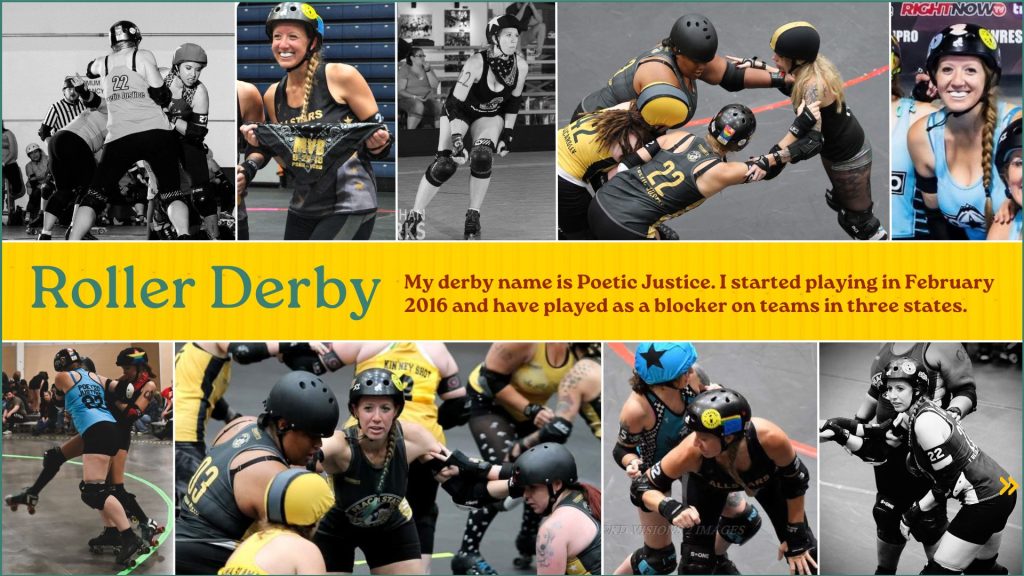

© 2024 Cat's Corner
Theme by Anders Noren — Up ↑